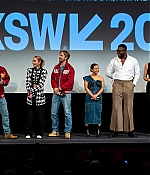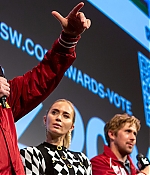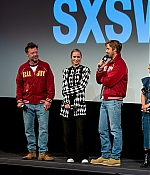
‘Mary Poppins Returns’: Emily Blunt Explains Why ‘I Am Not Julie Andrews’
Anne Thompson
January 11, 2019
Article taken from IndieWire.
“There’s an underbelly to Mary Poppins,” said Blunt, who embraced the duality of the P.L. Travers character as she sang and danced and cried through Rob Marshall’s musical sequel.
Anyone expecting too many spoonfuls of sugar in “Mary Poppins Returns,” Disney’s $130-million sequel to the Julie Andrews Disney classic set 25 years later in depression era London, will be disappointed. That’s because Emily Blunt, who reunited with her “Into the Woods” director Rob Marshall, returns some edge to the character created by British author P.L. Travers back in the 30s. “I get her,” Marshall said of Blunt. “I find her quick and clever; I knew she’d find her own way heading back to the books of refining this eccentric character.”
Mary Poppins in the books “was terribly funny,” Blunt told me. “For sure, the vanity and humor is there, but she’s not very sunny. She’s odd.”
Blunt’s Mary Poppins falls somewhere between the weird book character and Julie Andrews’ cheery 1964 creation. It helps to love the original movie because Marshall — who began his Broadway musical career as a choreographer and directed Oscar-winning “Chicago” before shooting his biggest-grosser at Disney, “Pirates of the Caribbean: On Stranger Tides” — has crafted a classic homage that is faithful and references the original score throughout.
“We all have the first film in our blood,” said Marshall. “It had to be in the style of that world. I didn’t want Mary Poppins to sing ‘Let It Go.’ I would have felt betrayed to all of a sudden force a new style into this world. It had to grow from the first film into something that needed to feel organic. It’s classic, it’s not old-fashioned. It tells a story. Our songs are book songs. We have an actual proper musical core and reprises.”
Marshall knows that audiences carry emotion with them from the old Sherman brothers songs, from “Let’s Go Fly a Kite” to “Feed the Birds,” which never failed to make Walt Disney cry. “I wanted to protect the original and do an homage and create a new story set 25 years later,” he said. “This is my most personal film. It’s who I am, what I love, deep in my blood. I feel in a way I was meant to do it.”
The movie’s sad Depression-era story brings Poppins back — sailing 50 feet down from the sky on a kite and landing on her feet, shot for real, unlike Andrews, with huge cranes and wires — to save the grown Jane and Michael Banks, who are struggling to save the shabby family home at 17 Cherry Tree Lane from a rapacious banker (Colin Firth), as well as Michael’s recently motherless kids.
“This is a sophisticated performance,” Marshall said to Blunt at a Q&A. “You’re playing a stern and reserved nanny and underneath are the layers, glimpses of humanity and humor and vulnerability, so it’s not a cartoon, its a real live person. There’s no film without Emily.”
Musicals are even bigger and harder than an action extravaganza like “Pirates of the Caribbean,” said Marshall: “Both have set pieces, choreography and staging.” He understood the challenges of making a book musical flow believably from dialogue into song, which is why he demanded a week of workshopping without any executives on hand.
“When a song doesn’t work when someone starts to sing, the audience says, ‘Oh why are they singing?’,” he said. “It’s important to earn a song. When it feels like the time for something to happen, it must feel seamless and organic and natural. Placing where a song goes is one of the most complicated parts. To tell a story, if you take it out it, it shouldn’t be able to work. A portion of a scene is taken away and turned into a song.”
The surviving Sherman brother, 90-year-old Richard, even gave notes on the new songs from five-time Oscar nominee Marc Shaiman (“South Park: Bigger, Longer & Uncut”), who was building on a 1930s sound. Nine songs made it into the final movie, but Marshall estimates that twice as many were written. Disney executives Alan Horn, Alan Bergman and Sean Bailey allowed Marshall to take three years to build this rare original musical from scratch, workshopping the script by David Magee (“Finding Neverland,” “Life of Pi”) and the music without interference and giving his two leads, Blunt and “Hamilton” creator Lin-Manuel Miranda, the chance to try out many songs that were never used, playing to their strengths.
“I am not Julie Andrews, I’m not a soprano,” said Blunt, who signed on to the project back in August 2015 and went through two months of intense rehearsal. “This is not ‘The Hills are Alive.’ The singing was a wonderful slow burn journey. They learned my voice. It was a collaborative workshop experience, the songs were made for us like a tailor-made suit.”
The trick of the movie is not only showing the tough blue-coated exterior of this stern, imperious, vain nanny who “is practically perfect in every way” — it took over an hour and a half to primp Blunt into such perfection for each shooting day — but her gleeful, magical interior, exemplified by the coat’s florescent orange polka-dotted lining (designed by Sandy Powell). “I love the duality of the character,” said Blunt. “She is imperious and vain and rude and funny and eccentric in front, and you open up this wild lining. There is an underbelly to Mary Poppins.”
The team went through five songs before they chose Poppins’ first number, “Can You Imagine That?” “It begins with a recitative,” said Marshall. “She’s speaking to the kids, and naturally moves into it. You earn the song when its warranted and words aren’t enough, so a song happens.”
The heart of the movie is one of two Oscar-contending songs, the ballad “The Place Where Lost Things Go,” which made Blunt cry each time she sang it. “I found it so moving, particularly having children of my own,” she said. “What would it be like for children without their mother, the house and everything falling apart at seams, all they want is a hug from their mother? I loved doing it on the day.”
When Poppins takes the children on their first adventure, plopping them into bubbly water for an underwater cruise, her eyes glint with impish mischief. “She’s like an adrenaline junkie,” said Blunt, who was inspired by both Princess Margaret and Rosalind Russell in “HIs Girl Friday.” “She can’t wait, she’s brimming with excitement to go on the adventure, it’s her way of releasing herself. She’s so thrilled by it. I said to Rob, ‘in the adventures she’s at her most elated, she smiles, her laughs are so oversized.’ He said, ‘Your job is to discover your child inside, you have to see that in her.’”
Blunt’s Mary Poppins is even a tad sexy in one scene, in a ruffled dress and short bob. “That music hall number is raunchy, funny, out there,” said Blunt. “I wanted to go all the way with a thick Cockney accent. It’s her way of satisfying and surrendering to that side of herself.” When Blunt was flung around by 30 lamplighters in the other Oscar-contending song “Trip the Light Fantastic,” “that was Mary Poppins’ dream as well, she was so excited!”
While the athletic Blunt trained as a dancer for “The Adjustment Bureau,” she doesn’t consider herself to be a dancer. “I’m not very good on a bicycle. I can move, but it takes me a long time to pick up steps,” she said. “I don’t see it and do it. I’m not that person. They handed me a bowler hat and cane and we were off to the races with the first number.”
Marshall demanded painstaking, costly 2D animation — 100 animators working in Pasadena included old-timers brought out of retirement to work alongside young animators in their 20s eager to learn — for the first scene they shot for the movie, an ambitious green-screen adventure inside the chipped china bowl. Carefully planned out via choreography, pre-vis animation and storyboards, the animators were on hand to watch the well-rehearsed shoot as Blunt, Miranda and and the children navigated a bare Shepperton soundstage with little green penguin dancers and eye-line tennis balls as Marshall said, “There’s the elephant! There’s a monkey on your head!” and supplied a giraffe head on a stick. “It was surreal,” said Blunt. “We were looking at marks on a wall.”
Miranda spent his free hours at Shepperton practicing riding his bike Gertie, which carried a heavy wooden ladder. For the number when everyone piles on the bike, said Marshall, “We had green trading wheels on either side, also the FX coordinator was controlling the hydraulics of the ladder going back and forth. We erased the wheels.”
When the original chimney-sweep Bert, Dick Van Dyke, came on set for his cameo, he told Marshall, “I feel the same spirit here as I did on the first film, I feel it.”
Blunt agreed. “That spirit stays with you and dwells within you,” she said. “I felt a loss when it was over, after two years it was hard to let go of.”
At the end of the movie, Angela Lansbury’s balloon lady, watching the entire neighborhood flying in the sky, says, “Of course, the grownups will forget by tomorrow.” Mary Poppins says, “They always do.” And Miranda’s lamplighter Jack says, “I won’t forget.”
For Marshall, “I hope that’s what people carry with them,” he said. “Some joy and hope, seeing things from a different angle. Hold on to that sense of wonder, don’t get too cynical, grownup or jaded, and you will find joy in your life.”
Screening reactions to the movie surprised Marshall and Blunt, as “Mary Poppins Returns” joins “RBG” and “Won’t You Be My Neighbor” as a film that makes people feel better during troubled times. “It’s about healing and joy,” said Blunt. “You see Michael Banks heal. She comes back for him. It’s about him. That’s the energy that comes at me after screenings: ‘I didn’t really know how much I needed her to come back.’ People went in feeling like a grown-up and left feeling like a child. All the hopeful, optimistic comments hit us between the eyes.”
“Mary Poppins Returns” landed on the National Board of Review and AFI Ten Best Lists, as well as nabbing crucial Golden Globe and Critics Choice Comedy/Musical nominations. While the movie didn’t score a SAG ensemble slot, Blunt did grab a SAG nod. The crafts are supporting the movie, which should land some nominations for production and costume design, score, and song.
Next up: For Marshall, Disney’s live-action “The Little Mermaid,” working with Miranda; Blunt, after a year of riches including SAG recognition for both “Poppins” and husband John Krasinski’s “A Quiet Place,” is taking some time off.















